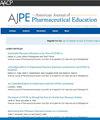Evaluation of Pediatric-Focused Immunization Training Offerings at United States Schools and Colleges of Pharmacy
IF 3.8
4区 教育学
Q1 EDUCATION, SCIENTIFIC DISCIPLINES
引用次数: 0
Abstract
Objective
To determine the prevalence, describe the content, and identify barriers to implementing pediatric-focused immunization training at United States (US) schools and colleges of pharmacy.
Methods
A cross-sectional survey was distributed to members of the American Association of Colleges of Pharmacy Laboratory Instructors Special Interest Group. The 22-item survey included multiple-choice, Likert scale, and select-all-that-apply questions. Skip logic was applied based on respondents’ selections. Descriptive statistics were used for data analysis.
Results
The response rate was 59.7% (71/119), with 58% of respondents from public institutions and 42% from private institutions. Nearly all respondents participated in immunization training at their institution as a program coordinator, didactic teacher, and/or technique assessment facilitator. Pediatric-focused immunization training was not offered by 72% of programs. Among programs that provided pediatric-focused training, the most common topics included administration strategies and correct injection techniques. The most frequently reported barriers to implementing pediatric-focused immunization training were limited curriculum space, cost to the school/college, facilitator comfort, and instructor workload.
Conclusion
Despite pharmacists’ expanded scope to administer immunizations to pediatric patients under the Public Readiness and Emergency Preparedness Act, most US schools and colleges of pharmacy do not offer pediatric-focused immunization training to student pharmacists. The most commonly reported barriers to implementation may be addressed by enhancing pediatric content in existing immunization certificate programs used within schools and colleges of pharmacy.
对美国药学院儿科免疫培训的评估。
目的:确定美国(US)药学院以儿科为重点的免疫培训的流行程度,描述其内容,并确定实施的障碍。方法:对美国药学院协会(AACP)实验室讲师特别兴趣小组(SIG)的成员进行横断面调查。22个项目的调查包括多项选择,李克特量表和选择所有适用的问题。根据被调查者的选择使用跳过逻辑。采用描述性统计进行数据分析。结果:回复率为59.7%(71/119),其中58%的受访者来自公立机构,42%的受访者来自私立机构。几乎所有答复者都以项目协调员、教学教师和/或技术评估促进者的身份参加了所在机构的免疫培训。72%的项目没有提供以儿科为重点的免疫培训。对于那些以儿科为重点的培训项目,最常见的主题包括给药策略和正确的注射技术。实施以儿科为重点的免疫培训最常见的障碍是课程空间有限、学校/大学成本、辅导员舒适度和教师工作量。结论:尽管根据PREP法案,药剂师扩大了为儿科患者提供免疫接种的范围,但大多数美国药学院并没有为药学学生提供以儿科为重点的免疫培训。实施这种培训的最常见的障碍可以通过加强中小学和药学院已经使用的免疫证书课程中的儿科内容来克服。
本文章由计算机程序翻译,如有差异,请以英文原文为准。
求助全文
约1分钟内获得全文
求助全文
来源期刊
CiteScore
4.30
自引率
15.20%
发文量
114
期刊介绍:
The Journal accepts unsolicited manuscripts that have not been published and are not under consideration for publication elsewhere. The Journal only considers material related to pharmaceutical education for publication. Authors must prepare manuscripts to conform to the Journal style (Author Instructions). All manuscripts are subject to peer review and approval by the editor prior to acceptance for publication. Reviewers are assigned by the editor with the advice of the editorial board as needed. Manuscripts are submitted and processed online (Submit a Manuscript) using Editorial Manager, an online manuscript tracking system that facilitates communication between the editorial office, editor, associate editors, reviewers, and authors.
After a manuscript is accepted, it is scheduled for publication in an upcoming issue of the Journal. All manuscripts are formatted and copyedited, and returned to the author for review and approval of the changes. Approximately 2 weeks prior to publication, the author receives an electronic proof of the article for final review and approval. Authors are not assessed page charges for publication.

 求助内容:
求助内容: 应助结果提醒方式:
应助结果提醒方式:


